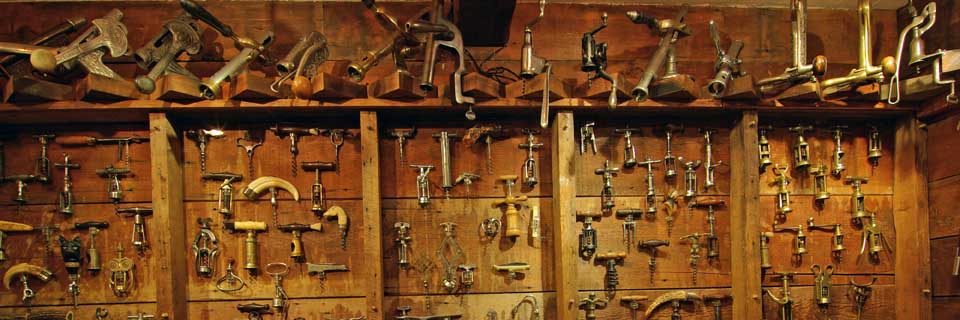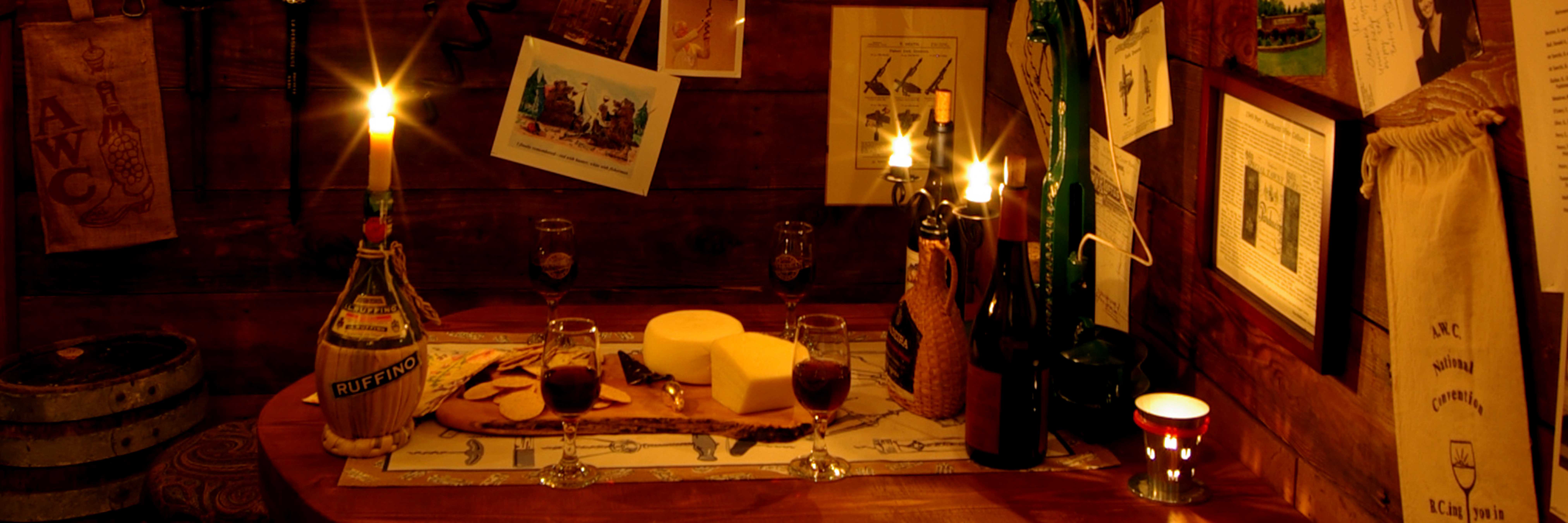


|
|
Anheuser BuschThis is an 1891 American corkscrew, patented by Edwin Walker, with an unusual Anheuser Busch advertising plate. In fact, it's the only one we've ever seen. The penny is there to give an idea of the size.ArcadeAmerican Michael Redlinger filed a patent for this corkscrew on December 23, 1893.BeaumontThis is the only known example of Michael Redlinger's 1895 patent.HandyFrom 1903, this wall-mounted "Handy" is the only one known.1893 ChampionThis American corkscrew was advertised at eighty cents.HektorThe only known example of the top-mounted "Hektor" patented in Germany in 1925.EnterpriseNot a starship, but a corkscrew dating from about 1886.GilchristMade in Chicago, patented in 1888.InfantaA petite bar corkscrew from about 1897, patented by American Harry Williams.InvincibleThis patent pending version was made in U.S.A., but advertised in Germany as a Echt amerikanischer Invincible-Entkorker and priced at 15 marks.JVAn unusual brass fish design, believed to be Belgian.EAWMade by Elektrogeräte Erich Weinert, Berlin; this East German prototype from the 1960's was never produced.LindstromThe first automatic bar corkscrew to be patented, it was invented in Sweden by P. F. Lindstrom in 1870. The only other one we know of is in a museum in Stockholm.McMasterAn American patent from 1896.MeridenAn 1894 advertisement claims this is "One of the best Cork Pulls for Hotels, Cafes and Club use."MilanoAn Italian version of the U.S. Champion.Phoenix No. 40Arcade Manufacturing Co. of Freeport, Illinois made a multitude of cast iron objects, including this 1903 bottle clamp version of the Phoenix No. 40.Phoenix No. 60"The arrangement of both levers of the No. 60 is most convenient, and as a result a rapid and powerful action is obtained." So claims an advertisement for this 1903 American corkscrew.RapidA clean-lined American corkscrew patented by Harry J. Williams on April 21, 1891.RexOne of many designs patented by Raymond Gilchrist around the turn of the last century, this one is a British manufactured prototype.Rotary EclipseA brass English monster, patented by F. Marwood on March 26, 1885.SamsonMade in Erie, Pennsylvania before 1900, this compact bar corkscrew accommodated an advertising plate that patrons would notice as they stood at the counter.ShomeePatented by Albert Baumgarten in 1900, this one was made in his Freeport, Illinois foundry.StanpatA pre-production sample of a British bar corkscrew manufactured by Samuel Mason in about 1894.TimesUniqueAn American design by Edwin Walker, from about 1902.VictorAn English patent, by Samuel Mason in 1890. Advertised as "The quickest Machine ever invented, and the easiest."Walker 1913An American patent from March 25, 1913, by Edwin Walker. This is the only one known to exist.Walker AutomaticThe ad said, "The entire machine is built to be an ornament as well as a useful article." Edwin Walker's patent dates to 1894.Walker ImprovedThis elegant corkscrew dates to 1888, another design by the prolific Edwin Walker.A 1The only known example of the top-mounted version of the 1902 British "A1." AlexanderwerkAn Arcade design patented in Germany in 1895, this is the only known example of the clamp-mounted Alexanderwerk.AlexanderwerkThis is the only one known of Walker's design, patented in Germany in 1896, meant to be mounted on top of a bar.L'AutomatiqueA French wall-mounted corkscrew from the 1930's; this is the only one known.BarrettAn 1888 American patent; this is the only one known of Mr. Barrett's corkscrews.Bison UniqueMade in Germany by Helmut Gebel in the 1920's, this one is, so far as we know, truly unique.BroderneManufactured by the Swedish Eskilstuna Company, this one is the only example found.BloeserThe foot pedal pulls the bottle off the cork in the operation of this 1886 American corkscrew patented by J. Bloeser.Little GiantA patent was applied for in 1900 and never received for this oxymoronically named corkscrew.HenviA European manufacturer produced this only known example. |
|||||||||||||||||||||||||||||||||||||||||||||||||||||||||||||||||||||||||||||||||||||||||||||||||||||||||||||||||||||||||||||||||||||||||||||||||||||||||||||||||||||||||||||||||||||||||||||||||||||||||||||||||||||||||||||||||||||||||||||||||||||||||||||||||||||||||||||||||||||||||||||||||||||||||||||||||||||||||||||||||||||||||||||||||||||||||||||||||||||||||||||||||||||||||||||||||||||||||||||||||||||||||||||||||||||||||||||||||||||||||||||||||||||||||||||||||||||||||||||||||||||||||||||||||||||||||||||||||||||||||||||||||||||||||||||||||||||||||||||||||||||||||||||||||||||||||||||||||||||||||||||||||||||||||||||||||||||||||||||||||||||||||||||||||||||||||||||||||||||||||||||||||||||||||||||||||||||||||||||||||||||||||||||||||||||||||||||||||||||||||||||||||||||||||||||||||||||||||||||||||